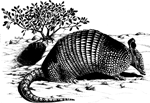Vertebrate Pest Conference Proceedings collection
Date of this Version
March 1980
Document Type
Article
Abstract
The systematic study of the roles of vertebrate pests in agriculture in Nigeria is relatively very young, having spanned only two decades. During this period the species composition of vertebrate pests has been determined in some important crop plants like cocoa (Taylor 1961, Everard 1968), oil palm (Greaves 1964), maize (Everard 1966; Funmilayo 1976) and rice (Funmilayo and Akande 1977). The ecology of a few important pest species has been studied. Because of its devastating destruction of many graminaceous crops in Nigeria and over most parts of Africa, the red-billed quelea (Quelea quelea) has been studied more intensively than other avian pests (Crook 1957; Crook and Ward 1968; Mallamaire 1959; Pope and Ward 1972; Park 1974; Ward 1965 a-d, 1966, 1971, 1972, 1973). Other avian pests whose ecology has been studied include the village weaverbird (Funmilayo 1975; Funmilayo and Akande 1976) and the bush fowl (Akande 1979). The ecology of some mammalian pests has also been studied (Ajayi 1975; Funmilayo 1975, 1979; Anadu 1976; Funmilayo and Akande 1979). A research program has been started at the University of Ibadan on the management, domestication and breeding of one of the most notorious rodent pests in Nigeria, the cane rat (Thryonomys swinderianus). The present report presents an up-to-date knowledge of the identity of those mammals and birds that cause damage on farmlands and in stores.

